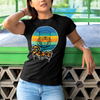Heat Transfer -vs- Screen Printing-vs- DTG Printing

Heat-transfer printing goes by many names including thermal printing, thermal-transfer printing and thermal-wax transfer. This process transfers an image to an object, such as a t-shirt, using heat. The image is first printed onto special paper or vinyl. In some cases, the image is produced by layering wax dye on a shirt or other item.
You can easily create your custom t-shirt at home using this method. All you need is a regular printer and heat transfer paper. An iron provides the heat you need. For small projects, this is a cost-effective method.
Heat transfer printing can also be used for large-scale projects, such as a business promotion. However, the heat transfer method is less economical for large projects.
Most people think of this as a technique to use for fabric items. But it can be used on wood, ceramics, plastic and more
What Is Screen Printing?
Screen printing uses a combination of ink transferred directly to the object and a stencil through which the ink passes to produce the design you want. The printing industry also refers to this as serigraph printing, silk screen printing and serigraphy. This printing method works on bags, t-shirts, glassware, backpacks, binders, flags, ceramics, signs and many other objects, including snowboards and skateboards. It costs less, too, unless you need small quantities.
This process requires a few steps, beginning with printing the design to transparent acetate film. The design is then cut out. The acetate film is placed on a mesh screen coated with a layer of light-reactive emulsion. To get the image you desire, you need to place your stencil down in reverse.
When exposed to light, the emulsion hardens, but the areas covered by the stencil will remain liquid. The liquid is then rinsed away, leaving you with a screen stencil. When printing a multi-colored design, a screen stencil must be created for each color.
This screen is laid over the fabric, and ink is poured onto the screen. The ink is spread evenly across the stencil using a squeegee. When creating multicolored designs, you must use extreme care to lay the screens in perfect alignment. This process works exceptionally well for commercial-size projects but is not cost-effective for small projects.
Pros and Cons
Heat transfer items can achieve highly detailed designs, so they look fantastic when first created. Unfortunately, they don’t age as well as screen-printed ones. You can achieve fine details with silk screen printing, but it is a meticulous process. On the plus side, as long as high-quality ink is used, screen-printed items can look great for a long time.
Direct-to-garment printing (DTG)
A newer method that utilizes a digital print head to print designs directly onto different surfaces, DTG printing is in a rapid growth phase.
DTG printers are functionally similar to the typical inkjet printer you'd find in a home or office. The process is fundamentally the same: an image is digitized by the printer and then printed directly onto the t-shirt or garment. Ink is sprayed onto the surface by carefully controlled print heads
DTG printing inks also require curing (like screen printing inks) to permanently adhere. Most DTG printing shops use a curing dryer or heat press to cure their products.
DTG printers range from small desktop sized models to units that require large climate-controlled garages.
Many envision a future where customers order online and a DTG printer automatically prints the shirt. While many businesses have attempted this, the technical and labor challenges have proven tremendous (even for Amazon). DTG printing is not as simple as pushing a button – there are many variables and factors to consider.
Why use DTG instead of screen printing?
Screen printing presses can print shirts quickly – sometimes up to 1,080 pieces an hour!
However, a screen printer's setup time limits what's possible. Screen printers can print one design at high volume quickly. But if they need to print multiple designs, or do just a few prints, screen printing can be prohibitively expensive compared to DTG printing.
Here's why: the extensive labor required to create, separate, coat, expose, and register screens makes the screen printing process inefficient for small quantity orders with lots of colors.
Let's say you want 20 t-shirts. A 4-color design usually requires 5 different screens to print (since you need an underbase screen).
It takes much more time to create those 5 screens and set them up on the screen printing press than it does to actually print the 20 shirts!
For small (12 pieces or less) orders with lots of colors, DTG printing is a great fit.
Karma Inc Apparel uses DTG printing exclusively for all Karma Inc Apparel products, providing our customers with the highest quality products in the industry!
#karmaincapparel #DTG #tshirts #hoodies #mens #womens #kids #children #americanmade #cotton #organiccotton #karma #kindness #clothing #trend #equality4all #brand
- Posted in 2022, American Made, American Made Clothing, Buy American, Care, Clothing, Clothing Reviews, Come Together, Compassion, Concern, Cotton, Eco friendly clothing, Empathy, Equality, Inclusion, Karma, Kids, Kindness, Love, Men, My Good Karma Blog, Peace, Respect, Sustainable, T-Shirt, T-Shirt Company, U.S.A., Unisex Clothing Review, Women





